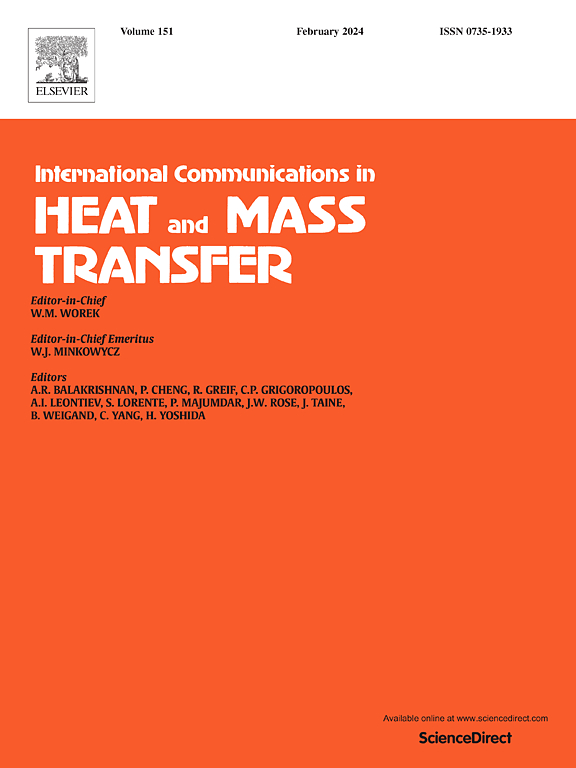小型散热器热管理优化的改进多目标遗传算法
IF 6.4
2区 工程技术
Q1 MECHANICS
International Communications in Heat and Mass Transfer
Pub Date : 2025-06-19
DOI:10.1016/j.icheatmasstransfer.2025.109229
引用次数: 0
摘要
本研究利用遗传算法对带翅片的小型散热器的多目标优化进行了深入的探索。目的是减少热阻和泵的功率消耗。优化问题包括使用增加的设计自由度:混合变量自由因子,包括鳍片角度、孔尺寸及其位置。采用计算流体力学(CFD)模拟对散热器的性能进行了评价。通过将连续变量限制为特定值,实现修复函数以优化解决方案,简化优化过程。结果揭示了热阻和泵功率之间的重要权衡,强调了平衡这些因素的重要性。优化过程在20小时内完成,与使用基本混合变量算法相比,所需时间减少了56%。优化的散热器设计显示出相当大的改进,有助于热工程技术的进步。该研究突出了所提出的遗传算法在优化热管理系统方面的有效性,并可为未来的研究提供参考。本文章由计算机程序翻译,如有差异,请以英文原文为准。
Enhanced multi-objective genetic algorithm for optimized thermal management in mini heat sinks
This research conducts an in-depth exploration of multi-objective optimization for a mini heat sink with fins using a genetic algorithm (GA). The objective is to reduce both thermal resistance and pump power consumption. The optimization problem consists of the use of increased design freedom: mixed-variable freedom factors, including fin angles, hole dimensions, and their placements. Computational fluid dynamics (CFD) simulations are used to evaluate the performance of the heat sink. A repair function is implemented to refine solutions by restricting continuous variables to specific values, streamlining the optimization process. The results reveal significant trade-offs between thermal resistance and pump power, emphasizing the importance of balancing these factors. The optimization process, completed in 20 h, cuts down the required time by 56 % compared to using a basic mixed variable algorithm. The optimized heat sink designs demonstrate considerable improvements, contributing to advancements in thermal engineering techniques. This study highlights the effectiveness of the proposed genetic algorithm in optimizing thermal management systems and may serve as a reference for future studies.
求助全文
通过发布文献求助,成功后即可免费获取论文全文。
去求助
来源期刊
CiteScore
11.00
自引率
10.00%
发文量
648
审稿时长
32 days
期刊介绍:
International Communications in Heat and Mass Transfer serves as a world forum for the rapid dissemination of new ideas, new measurement techniques, preliminary findings of ongoing investigations, discussions, and criticisms in the field of heat and mass transfer. Two types of manuscript will be considered for publication: communications (short reports of new work or discussions of work which has already been published) and summaries (abstracts of reports, theses or manuscripts which are too long for publication in full). Together with its companion publication, International Journal of Heat and Mass Transfer, with which it shares the same Board of Editors, this journal is read by research workers and engineers throughout the world.

 求助内容:
求助内容: 应助结果提醒方式:
应助结果提醒方式:


